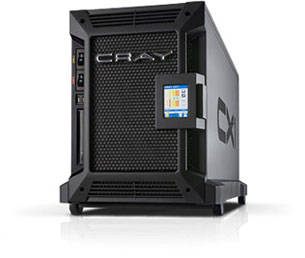Base Pricing for Entry-Level Supercomputer Starts at Less Than $12k
Cray expands its HPC offerings for more engineers and scientists with lower cost supercomputer.
August 10, 2009
By Anthony J. Lockwood
 Cray Inc. has reduced the entry-level pricing for its HPC (high-performance computing) systems with the introduction of the Cray CX1-LC (Light Configuration) deskside supercomputer. Cray says that, with a base price of less than $12,000, the CX1-LC system will allow more engineers and scientists to realize the productivity benefits of supercomputing.
Cray Inc. has reduced the entry-level pricing for its HPC (high-performance computing) systems with the introduction of the Cray CX1-LC (Light Configuration) deskside supercomputer. Cray says that, with a base price of less than $12,000, the CX1-LC system will allow more engineers and scientists to realize the productivity benefits of supercomputing.
Available immediately, the Cray CX1-LC is designed around Cray’s cluster architecture. It uses familiar working environments such as Windows HPC Server 2008 and Red Hat Enterprise Linux. This means that the CX1-LC supercomputer can place the dual benefits of a very high-end workstation and a small cluster at a user’s desk. The Cray CX1-LC system can also be upgraded to a full Cray CX1 supercomputer.
“The original Cray CX1 system has proven to be a productive, powerful, and easy-to-use HPC product for a growing number of researchers and scientists who have turned to Cray for their deskside supercomputing needs,” said Ian Miller, senior vice president of the productivity and solutions group and marketing at Cray in a press statement. “We expect the Cray CX1-LC will extend these benefits to an even larger number of HPC users.”
The CX1-LC is available with up to eight Intel Xeon Processor 5500 Series and is certified as an Intel Cluster Ready System. It supports up to four compute blades, including visualization and GPGPU blades in a simplified Cray CX1 chassis. As with the original Cray CX1 system, the Cray CX1-LC can be configured with storage options that include solid-state drives (SSDs) or large capacity, fixed-drive storage blades.
The Cray CX1-LC system introduces two new, lower-cost compute blades than the standard blades offered in the Cray CX1 system. One supports Gigabit Ethernet and is oriented to the workstation user. The other offers DDR InfiniBand and is oriented to the small cluster user.
For more information, visit Cray, Inc.
Go to the Cray CX1-LC configuration page.
Click here to access videos and to download datasheets, white papers, etc.
See why DE‘s editors selected the Cray CX1-LC as their Pick of the Week.
Subscribe to our FREE magazine, FREE email newsletters or both!
About the Author
Anthony J. Lockwood is Digital Engineering’s founding editor. He is now retired. Contact him via [email protected].
Follow DE





